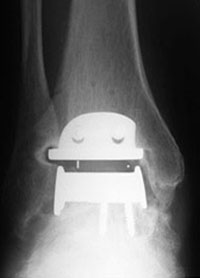When considering ankle surgery there are 2 main options to consider.
Arthroplasty or Ankle Replacement
In this procedure, your surgeon removes the damaged ankle joint and replaces it with an artificial implant.
Arthrodesis or Ankle Fusion
A fusion, also called an arthrodesis involves fusing the bones of the joint together using metal wires or screws.
Before deciding on which treatment is best for you please consult with your surgeon.
Arthroplasty or Joint Replacement.

A total ankle replacement is an artificial joint that resurfaces both sides of the ankle joint in order to relieve pain caused by arthritis and maintain range of
motion of the ankle.
The ankle joint connects the leg to the foot and is made up of a cartilage covered surface at the end of the tibia (or shin) bone which joins with a cartilage covered surface on the talus (or ankle) bone. The surgery will replace the cartilage on these two surfaces with a metal on polyethylene “bearing” surface that are firmly attached to the bone. Motion between these two joint surfaces is what allows the up and down movement of the foot.
Ankle replacement generally maintains the range of movement which a patient has pre-operatively. It is not suitable for heavy manual or sporting activities and probably has a ten year survivorship in the region of 85%. This disadvantage of relatively limited evidence as to their longevity is one of the main factors to consider before implantation.
Arthrodesis or Ankle Fusion.

Ankle fusion involves preparing both sides of the joint back to healthy and bleeding bone. The arthritic joint lining is removed and the ankle joint is placed in a functional position and held there until the bone has grown across the joint and the ankle is thus fused. The ankle is held in position whilst the fusion is occurring and this is most commonly done with large screws which are buried beneath the skin. Occasionally a large metal rod may need to be inserted through the heel to compress the ankle and sub-talar joints (known as a double fusion). In cases where infection is present a device known as an Ilizarov frame may be used to compress the ankle joint and hold it in position until fusion has occurred. On average it takes three months for bone to be fairly soundly fused but on occasion it can take significantly longer.
Ankle fusion for ankle osteoarthritis is a good option for younger and more active patients. A return to heavy manual occupations and potentially also sport is possible. A return to sport after ankle fusion is largely determined by the mobility of the compensatory joints which are left intact.
You can read more about Arthrodesis here
Potential Complications.
There are complications that relate to surgery in general. These include the risks associated with anesthesia, infection, damage to nerves and blood vessels, and bleeding or blood clots.
A specific risk associated with ankle arthrodesis is nonunion. This is failure of the ankle bones to fuse together. The ankle bones successfully fuse in more than 90 percent of operations, so the risk is relatively low. If nonunion does occur, a second operation to place bone graft in the ankle and place new hardware may be needed.
Loss of motion in the ankle after a fusion causes the other joints in the foot to bear more stress than they did prior to the surgery. This can lead to an increased rate of arthritis in those other joints. This typically takes several years to develop and may or may not be symptomatic.
Find out hot to comply with your surgeons instruction on no weight bearing after surgery.
